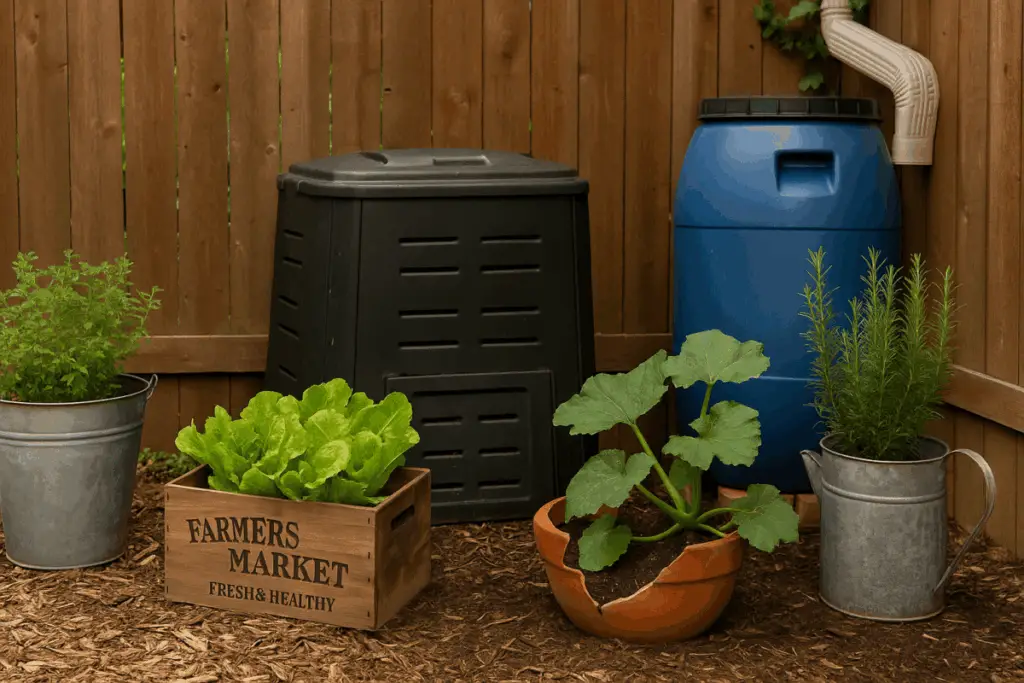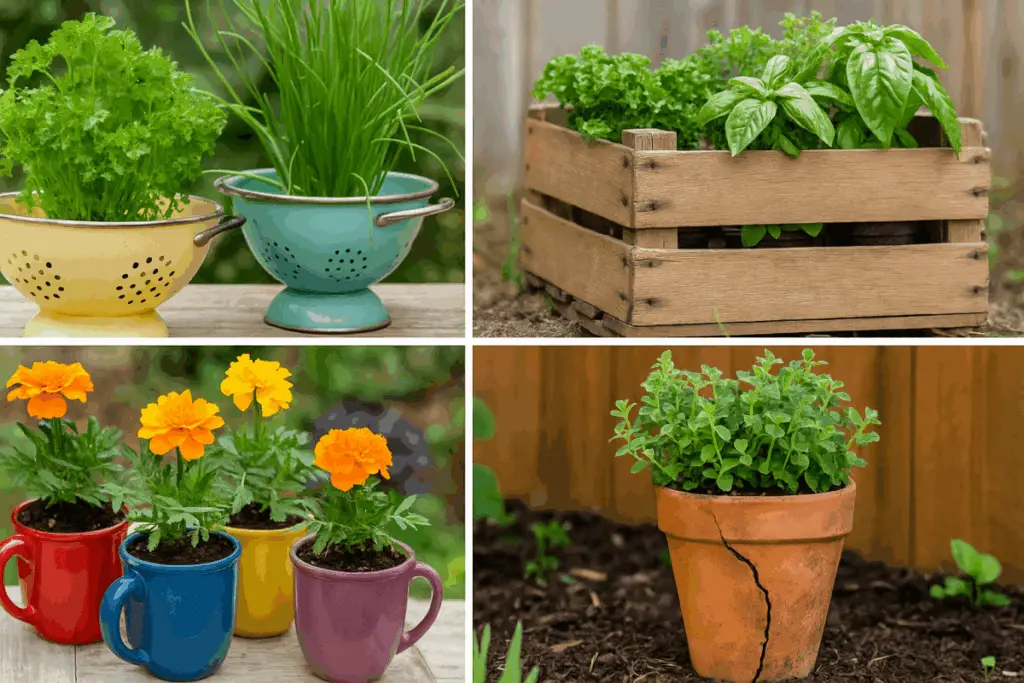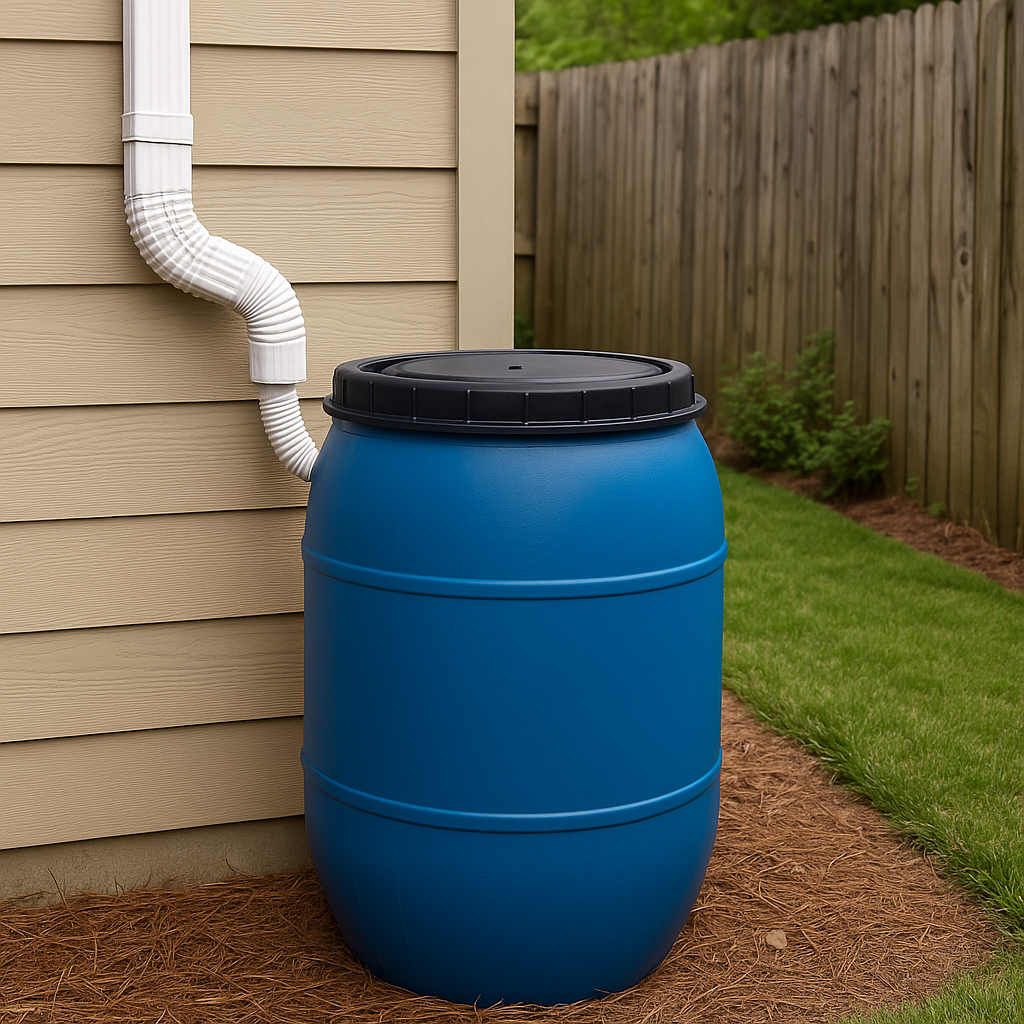Introduction

So here’s the thing—urban gardens are awesome, but they can still create a surprising amount of waste. We’re talking everything from broken seed trays and plastic pots to food scraps and packaging. According to the EPA’s home composting guide, yard trimmings and food waste made up more than 30% of what we throw away—and a lot of that could be composted or reused instead.
If you’re like me, you’re already doing your best to garden green. But it’s easy to miss the little stuff—like tossing your coffee grounds instead of turning them into fertilizer, or forgetting that cracked old planter might just need a drainage hole and a coat of non-toxic paint.
The good news? You don’t need a fancy setup or a ton of time to garden zero-waste. It’s more about being a little more mindful, reusing what’s already around you, and building some new habits that save money and make your garden healthier.
In this guide, I’ll walk you through seven simple, low-effort tricks that can help you cut garden waste while keeping things easy, affordable, and fun. You’ll learn how to turn scraps into gold (compost tea, anyone?), use everyday stuff as planters, and even save water without buying new gear.
Let’s roll up our sleeves and make the most of what we’ve already got. Your garden (and the planet) will thank you.
Why Zero-Waste Gardening Matters
The Hidden Waste Problem in Gardens
Even though gardening feels eco-friendly, a lot of plastic and packaging still sneaks in. Think seedling trays, fertilizer bags, single-use planters—it all adds up. And while some materials are recyclable, many of them aren’t, especially once they’ve been out in the sun and rain.
According to the EPA’s waste and recycling data, composting and yard trimming recovery has improved over the years, but millions of tons still head to landfills each year.
Why It’s Worth Fixing
Here’s why going zero-waste in the garden makes sense:
- Less trash in landfills. That’s good for your conscience and for the planet.
- Better soil, stronger plants. When you compost or mulch your waste, you’re feeding your soil.
- Money stays in your pocket. Reusing what you already have cuts down on buying new supplies.
Real Talk: Is This Actually Doable?
Absolutely. Zero-waste gardening doesn’t mean doing everything perfectly—it just means being smarter about the little things. And trust me, they add up fast. Every reused pot, every composted peel, every swapped seed packet is a step in the right direction.
Stick with me, and I’ll show you how to make it happen in your own space—no matter how big or small.
Trick #1: Upcycle Household Items as Plant Containers
This one’s an easy win. Instead of tossing out that cracked mixing bowl or dented metal bucket, turn it into a planter. Upcycling old household items into garden containers is a fun, creative way to cut down on waste and add character to your space.
What to Use
- Old kitchenware like colanders or chipped mugs
- Wooden crates or dresser drawers
- Buckets, bins, or broken laundry baskets
Just make sure whatever you’re using has good drainage. You can drill holes in the bottom or line the base with gravel or broken pottery shards. Want to go the extra step? Use non-toxic, biodegradable sealants or natural linseed oil to protect wood containers without leaching chemicals into your soil.
Why It Works
Besides saving items from the landfill, you’re also cutting down on buying plastic pots, which are notoriously difficult to recycle and often end up in landfills. According to the Sustainable Packaging Coalition’s recycling resource, many municipal recycling programs do not accept black plastic plant pots because they’re not detected by optical sorting equipment.

Pro tip: Group containers by height and color for a mini container garden that’s as photogenic as it is practical.
Small changes like these are the heart of zero-waste gardening: practical, affordable, and honestly, a lot more fun than buying more stuff.
Trick #2: Organic Fertilizer from Kitchen Scraps
If you’re tossing your coffee grounds or vegetable peels, you’re throwing away garden gold. Turning kitchen scraps into organic fertilizer is a smart, no-fuss way to build healthier soil while keeping food waste out of the trash.
Here’s How to Start
- Save your scraps: Collect things like carrot tops, eggshells, coffee grounds, and tea bags (skip anything greasy or meat-based).
- Choose a method: For smaller gardens or patios, options like bokashi composting or trench composting work great—even in tight spaces.
- Apply to soil: After your scraps have broken down, mix them into your garden beds or make a diluted “compost tea” to water your plants.
Why It Matters
The University of Minnesota Extension explains how bokashi composting speeds up the breakdown of kitchen waste while keeping odors in check. Plus, it creates a nutrient-rich soil conditioner that helps boost plant growth naturally.
Bonus Tip: Want to go a step further? You can ferment scraps into a liquid fertilizer. Just soak the broken-down materials in water for a few days, then strain and use the liquid on your plants.
That’s it—free, effective fertilizer made right in your kitchen. Let’s keep going!
Trick #3: Chemical-Free Natural Weed Control
Weeds happen—it’s part of gardening. But you don’t have to reach for harsh chemical sprays to deal with them. There are natural weed control methods that are cheap, easy, and safe for your plants and the environment.
Smart, Safe Solutions
- Sheet mulching: Use cardboard or layers of newspaper topped with mulch to block out sunlight and smother weeds.
- Boiling water: For sidewalks and cracks in patios, a pour of boiling water can zap weeds instantly.
- Vinegar spray: Mix vinegar with a bit of dish soap and apply directly to unwanted plants. (Use carefully—it doesn’t discriminate!)
A Real-Life Win
One community garden in Portland, Oregon, reduced its use of chemical weed control by over 90% just by implementing regular mulching and boiling water treatments. It’s low-cost, low-effort, and keeps the soil healthy.
Pro tip: Preventing weeds is easier than treating them. Keep beds densely planted and top off mulch as it breaks down.
Nature-friendly and gardener-approved—now that’s a win-win. Ready to save water next?
Trick #4: Harvest Rainwater for Efficient Watering
If you’re paying for water to keep your plants happy, you might be missing out on one of the easiest zero-waste hacks: collecting rainwater. Not only is it free, it’s also better for your garden since it’s free from chlorine and other treatment chemicals.
How to Set Up a Simple System
- Use a barrel or large container to catch rain from your gutters.
- Install a screen or mesh over the top to keep out debris and mosquitoes.
- Add a spigot to the bottom for easy access, and elevate the barrel to improve flow.
For those new to the idea, the University of Georgia Extension offers a great overview of how to harvest and store rainwater safely.
Why It’s Worth It
One study found that a single rain barrel can save over 1,300 gallons of water during peak summer months. Multiply that by a few containers and you’re looking at real savings—not to mention a lighter environmental footprint.

Pro tip: Use collected water early in the morning to reduce evaporation and get more bang for your barrel.
Collecting rain isn’t just for the pros. It’s easy to set up, great for your plants, and totally in line with a low-waste lifestyle. On to the next!
Trick #5: Brew Nutrient-Rich Compost Tea
If your garden could use a little boost, compost tea is like a smoothie for your plants. It’s packed with nutrients, super easy to make, and helps your soil teem with beneficial microbes.
What Is It?
Compost tea is a liquid fertilizer made by soaking compost in water. The result is a microbe-rich solution that gives plants a fast, natural nutrient boost—without the chemical runoff.
How to Brew It
- Start with mature compost: Use homemade compost or high-quality bagged compost that’s free of synthetic additives.
- Fill a 5-gallon bucket about one-third full with compost, then add water (preferably rainwater or dechlorinated tap water).
- Stir daily and let steep for 2–3 days in a shady spot. For extra aeration, some gardeners add an aquarium bubbler.
- Strain and apply: Use a watering can or spray bottle to apply to plant roots and leaves.
According to the University of Illinois Extension, compost tea may support soil biodiversity and boost disease resistance in certain plants when used consistently.
Pro tip: Apply compost tea early in the morning or on overcast days to help beneficial microbes survive longer on plant leaves.
It’s low-effort, high-reward—and once you see the difference in your plants, it just might become a regular part of your garden routine.
Next up: turning your own garden waste into mulch that feeds your soil and cuts down your yard work.
Trick #6: Repurpose Garden Waste as Mulch
Your garden might already be growing one of its best resources: mulch. Instead of bagging up fallen leaves, grass clippings, and trimmed branches, you can turn them into a protective layer that nourishes your soil and keeps weeds in check.
What You Can Use
- Leaves: Shred them if you can to help them break down faster.
- Grass clippings: Use in thin layers to avoid matting and odor.
- Small branches and twigs: Run them through a chipper or use them around perennials.
- Pruned plant matter: As long as it’s disease-free, it’s good mulch material.
Why It’s Worth It
The University of New Hampshire Extension points out that mulch helps regulate soil temperature, conserve moisture, reduce erosion, and improve soil structure over time. Best of all, when made from your own garden waste, it’s free and sustainable.

How to Apply
- Layer 2–4 inches deep around plants, keeping a little space around stems to avoid rot.
- Replenish as needed—organic mulch will break down over time and feed your soil.
Pro tip: Don’t use weeds that have gone to seed or invasive plants—they could cause more trouble than they solve.
This is zero-waste at its finest: turning would-be trash into something your garden will actually thank you for. Let’s finish strong with one last trick: swapping seeds instead of buying new ones in packaging every season.
Trick #7: Swap Seeds Locally to Cut Packaging Waste
Buying new seed packets every season might seem harmless—but over time, those little envelopes add up. From the glossy packaging to the shipping footprint, it’s another hidden source of garden waste. Swapping seeds with other gardeners cuts packaging waste, saves money, and helps preserve heirloom varieties.
How to Start a Seed Swap
- Join local gardening groups on Facebook or community bulletin boards.
- Visit your library: Many public libraries now host seed banks or swaps—check out the Richmond Grows Seed Lending Library as an example.
- Organize your own: Invite friends or neighbors to bring leftover seeds and label them with planting tips and dates.
Why It Works
Besides the environmental benefits, swapping seeds helps you grow plants adapted to your local climate and soil. That means stronger plants and better harvests. Plus, sharing seeds builds community—something every garden needs.
The Seed Savers Exchange encourages this kind of local sharing to help protect biodiversity and preserve rare plant genetics. It’s a win for sustainability and food resilience.
Tips for Success
- Label everything with plant name, harvest year, and any special notes.
- Store seeds in a cool, dry place until you’re ready to plant.
- Swap before the growing season to give everyone time to plan their garden beds.
Pro tip: Save seeds from your healthiest, most productive plants to keep your local varieties strong.
Swapping seeds keeps the gardening cycle going without the waste—and it’s way more personal than anything you’ll get in a store.
Final Thoughts: Start Your Zero-Waste Garden Today
If you’ve made it this far, you’re already thinking like a zero-waste gardener—and that’s half the battle. This isn’t about perfection. It’s about progress. Little habits, like composting your scraps or skipping the plastic pots, really do add up over time.
You don’t need a big budget, a huge yard, or fancy equipment. Just a bit of creativity, a willingness to reuse what you’ve already got, and a mindset that says, “Let’s make it work.”

Ready to Take Action?
- Pick one of these tricks and start this weekend.
- Share your progress with fellow gardeners online or in your neighborhood.
- Host a mini seed swap or compost workshop.
If you’re looking for a simple way to start, download our free Zero-Waste Garden Checklist to help you track what you’ve already done and what you’d like to try next.
Pro tip: Celebrate your progress, even if it’s small. Every banana peel you compost, every rain barrel you fill, and every seed you share is a win.
Thanks for growing greener with us—your garden (and the planet) is better for it.
FAQ: Zero-Waste Gardening
What is zero-waste gardening?
Zero-waste gardening is about reducing or eliminating waste throughout your gardening process. That means reusing materials, composting kitchen and yard waste, avoiding single-use plastics, and sourcing seeds and tools sustainably. It’s a mindset as much as a method.
Can I practice zero-waste gardening in a small space?
Absolutely. Even if you only have a balcony or a few containers, you can compost in small batches (bokashi works great), use upcycled planters, collect rainwater with compact barrels, and swap seeds with others to cut packaging waste.
How do I know what’s safe to compost?
Stick to fruit and vegetable scraps, coffee grounds, eggshells, yard trimmings, and paper without glossy ink. Avoid meat, dairy, and greasy foods as they can attract pests and smell. The EPA’s composting guide has a helpful list.
Do I need fancy equipment to make compost tea?
Not at all. All you need is mature compost, a bucket, and water. Stir it daily and let it steep for a couple of days. If you want to step it up, you can add an aquarium bubbler for extra oxygen, but it’s totally optional.
Is rainwater safe for watering vegetables?
Yes—rainwater is actually better than tap water in most cases because it’s free from chlorine and fluoride. Just make sure to collect it safely using a screened barrel, and don’t let it sit stagnant for too long.
Where can I find a local seed swap?
Check with your local library, community garden, or extension service. Many gardening groups on Facebook or Nextdoor also host seasonal swaps. You can even start your own—just invite a few gardeners and bring extra seeds to share.

